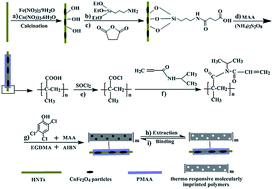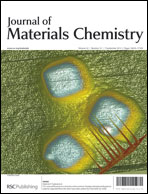Switched recognition and release ability of temperature responsive molecularly imprinted polymers based on magnetic halloysite nanotubes
Abstract
CoFe2O4/halloysite nanotube magnetic composites (MHNTs) were firstly achieved via a wet impregnation technique, and then a thermal polymerization under (NH4)2S2O8 chain initiation in water was employed to obtain methacrylic acid-functionalized MHNTs (MAA-MHNTs). By decorating the MAA-MHNTs with the temperature responsive monomer N-isopropylacrylamide (NIPAM), a novel temperature responsive molecularly imprinted material based on the obtained NIPAM-MHNTs (TMMIPs) was synthesized by a surface imprinting technique. The results of characterization indicated that the TMMIPs exhibited magnetic sensitivity (Ms = 1.758 emu g−1), magnetic stability (in the pH range of 2.0–8.0), thermal stability (especially below 200 °C) and contained a temperature responsive imprinted layer (the lower critical solution temperature was 33.96 °C). Then the TMMIPs were applied to switched recognition and release of 2,4,5-trichlorophenol molecules (5-TCP) by changing the medium temperature. TMMIPs showed outstanding recognition ability towards the imprinted species under high temperature conditions (such as 60 °C), due to the loss of hydration and a collapsed state of inter-poly(N-isopropylacrylamide), which resulted in the formation of a specific structure between 5-TCP and the polymer network. In contrast, at relatively low temperatures (such as 20 °C), the captured 5-TCP was released from the swelled TMMIPs, which resulted from increasing the distance between 5-TCP and the polymer network. The selective analysis demonstrated the high affinity and selectivity of TMMIPs towards 5-TCP over competitive phenolic compounds, and the specific recognition of binding sites may be based on the distinct size, structure and functional groups of the template molecules.


 Please wait while we load your content...
Please wait while we load your content...